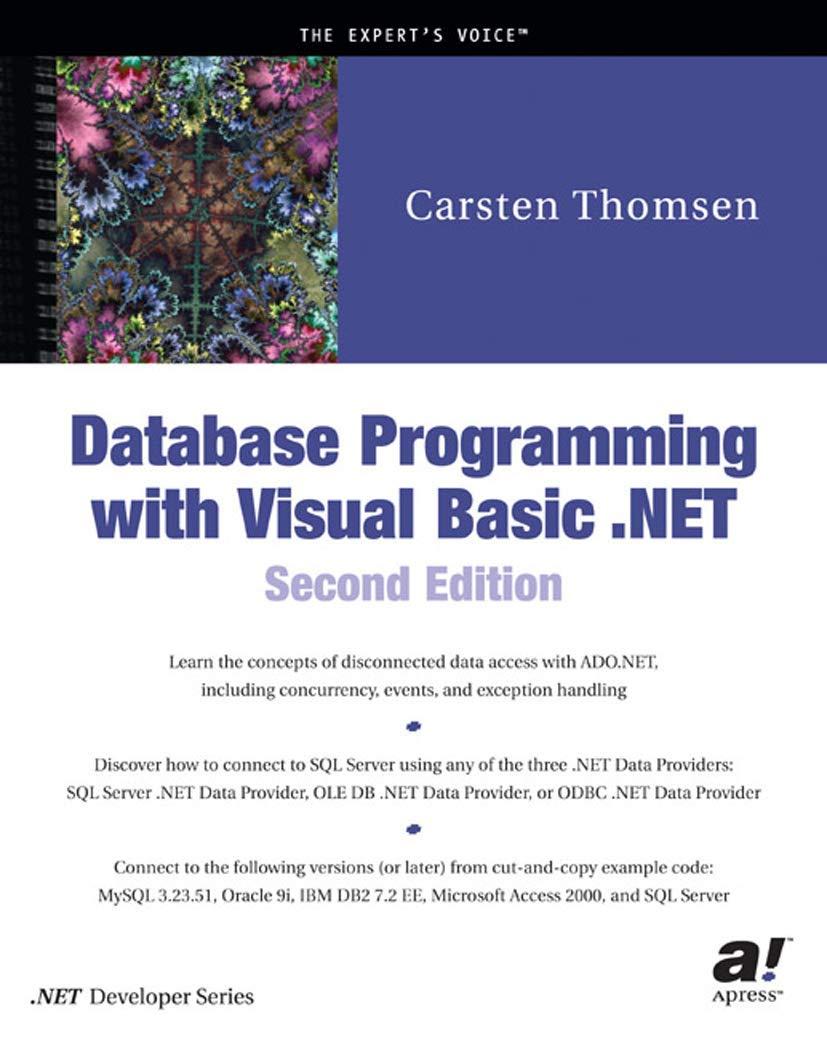Question
Question 11 Which of the following is NOT a method of the class Throwable? getMessage throwMessage printStackTrace toString 1 points Question 12 import java.util.*; public
Question 11
Which of the following is NOT a method of the class Throwable?
| getMessage | ||
| throwMessage | ||
| printStackTrace | ||
| toString |
1 points
Question 12
import java.util.*; public class ExceptionExample1 { static Scanner console = new Scanner(System.in); public static void main(String[] args) { int dividend, divisor, quotient; try { System.out.print("Enter dividend: "); dividend = console.nextInt(); System.out.println(); System.out.print("Enter divisor: "); divisor = console.nextInt(); System.out.println(); quotient = dividend / divisor; System.out.println("quotient = " + quotient); } catch (ArithmeticException aeRef) { System.out.println("Exception" + aeRef.toString()); } catch (InputMismatchException imeRef) { System.out.println("Exception " + imeRef.toString()); } catch( IOException ioeRef) { System.out.println("Exception " + ioeRef.toString()); } } } Which of the following will cause the first exception to occur in the code in the accompanying figure?
| If the divisor is zero | ||
| If the dividend is zero | ||
| If the quotient is zero | ||
| This code will not compile, so an exception cannot be triggered. |
1 points
Question 13
import java.util.*; public class ExceptionExample1 { static Scanner console = new Scanner(System.in); public static void main(String[] args) { int dividend, divisor, quotient; try { System.out.print("Enter dividend: "); dividend = console.nextInt(); System.out.println(); System.out.print("Enter divisor: "); divisor = console.nextInt(); System.out.println(); quotient = dividend / divisor; System.out.println("quotient = " + quotient); } catch (ArithmeticException aeRef) { System.out.println("Exception" + aeRef.toString()); } catch (InputMismatchException imeRef) { System.out.println("Exception " + imeRef.toString()); } catch( IOException ioeRef) { System.out.println("Exception " + ioeRef.toString()); } } } Which of the following inputs would be caught by the second catch block in the program in the accompanying figure?
| 0 | ||
| 10 | ||
| h3 | ||
| -1 |
1 points
Question 14
Which of the following is NOT a typical action of the catch block?
| Completely handling the exception | ||
| Partially processing of the exception | ||
| Rethrowing the same exception for the calling environment | ||
| Throwing the exception |
1 points
Question 15
What happens in a method if there is an exception thrown in a try block but there is no catch block following the try block?
| The program ignores the exception. | ||
| The program will not compile without a complete try/catch structure. | ||
| The program terminates immediately. | ||
| The program throws an exception and proceeds to execute the finallyblock. |
1 points
Question 16
Which of the following exceptions might be thrown by the methods of the class String?
| NullPointerException | ||
| FileNotFoundException | ||
| NoSuchElementsException | ||
| NumberFormatException |
1 points
Question 17
How many finally blocks can there be in a try/catch structure?
| There must be one finally block. | ||
| There can be one finally block following each catch block. | ||
| There can be zero or one finally blocks following the last catch block. | ||
| There is no limit to the number of finally blocks following the last catchblock. |
1 points
Question 18
The class RuntimeException is the superclass of which of the following classes?
| NullPointerException | ||
| NoSuchMethodException | ||
| IllegalAccessException | ||
| NoSuchFileException |
1 points
Question 19
Which of the following statements is true?
| The class Exception, which is derived from the class Object, is the superclass of the class Throwable. | ||
| The class Throwable, which is derived from the class Exception, is the superclass of the class Object. | ||
| The class Throwable, which is derived from the class Object, is the superclass of the class Exception. | ||
| None of these |
1 points
Question 20
import java.util.*; public class ExceptionExample1 { static Scanner console = new Scanner(System.in); public static void main(String[] args) { int dividend, divisor, quotient; try { System.out.print("Enter dividend: "); dividend = console.nextInt(); System.out.println(); System.out.print("Enter divisor: "); divisor = console.nextInt(); System.out.println(); quotient = dividend / divisor; System.out.println("quotient = " + quotient); } catch (ArithmeticException aeRef) { System.out.println("Exception" + aeRef.toString()); } catch (InputMismatchException imeRef) { System.out.println("Exception " + imeRef.toString()); } catch( IOException ioeRef) { System.out.println("Exception " + ioeRef.toString()); } } } Which method throws the second exception in the code in the accompanying figure?
| nextInt | ||
| toString | ||
| println | ||
| nextLine |
Step by Step Solution
There are 3 Steps involved in it
Step: 1

Get Instant Access to Expert-Tailored Solutions
See step-by-step solutions with expert insights and AI powered tools for academic success
Step: 2

Step: 3

Ace Your Homework with AI
Get the answers you need in no time with our AI-driven, step-by-step assistance
Get Started


